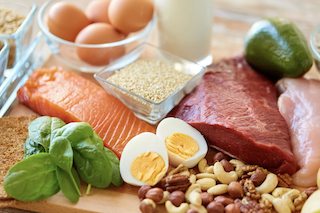Physio Hub:
Evidence-Based Article
Losing Belly Fat
~ A Science-Based Approach ~
If you ever tried to hold your stomach in to hide that dreaded belly pouch, you are not alone.
Belly fat is a common issue for many adults. But why is belly fat so stubborn, and more importantly, how do you lose it?
Losing belly fat goes beyond how you look. Losing the fat around your midsection can help reduce the risk of certain diseases. Excess abdominal fat can also contribute to lower back pain. There is no shortage of information on how to lose belly fat. Advertisements promote everything from pills to fad diets, making it confusing to determine what works.
Today, we examine a multifaceted approach to losing and sustaining belly fat loss.
Why Belly Fat Is Stubborn?
Belly fat is the fat around your abdomen. Doctors classify belly fat into two types, including:
- Visceral: Visceral fat surrounds your organs.
- Subcutaneous: Subcutaneous fat is under the skin.
According to Harvard Health, visceral fat is linked to an increased risk of cardiovascular disease, type 2 diabetes, and metabolic disturbances. It is vital to lose visceral fat due to those health risks.
But it can be challenging to lose abdominal fat, especially as a person ages. Genetics, age, and lifestyle influence visceral fat and sometimes make it stubborn. Belly fat also releases certain hormones that make your body hold on to the fat, which leads to difficulty losing weight.
Effective Exercises for Belly Fat
It is important to understand you cannot spot reduce by doing certain exercises. But exercise can play a role in losing belly fat. Effective strategies for belly fat loss include:
High-intensity interval training (HIIT): Research in the journal Sports Medicine found that HITT is an efficient strategy for reducing fat mass deposits, including abdominal fat. HIIT training involves alternating quick bursts of maximal effort or near-maximal intensity followed by a recovery period of less intense exercise. The study also found that HIIT that involves running was more effective than other exercise, such as cycling.
Sprint interval training (SIT): SIT is a form of HIIT. It involves intervals of sprinting with slower jogging or running. Research published in Applied Physiology, Nutrition, and Metabolism involved women who completed a six-week SIT exercise program. The training decreased body fat mass by 8% and waist circumference by 3.5%.
It is also vital to be aware of misinformation and unrealistic expectations. Studies have indicated that many people seek fast, easy ways to lose weight and decrease belly fat. Trying fad diets or fat loss methods that are not evidence-based often leads to disappointment.
Comprehensive Belly Fat Loss Plan
Taking a comprehensive approach is optimal to having the best chance of successfully losing belly fat and keeping it off.
A comprehensive plan to lose belly fat includes diet, exercise, and sufficient sleep. Research in Sleep Medicine found a significant association between insufficient sleep and an increase in visceral fat. Additional research in the Annals of Internal Medicine found that lack of sleep may also adversely affect attempts to lose fat through diet.
When it comes to dietary efforts, focusing on high protein intake appears to help. Multiple studies indicate that higher protein intake may decrease visceral fat. For instance, research in the Journal of Obesity and Metabolic Syndrome found that consuming more protein than the recommended daily allowance reduced body weight and decreased fat mass while preserving muscle mass.
It is helpful to focus on lean protein, including:
- Turkey
- Lean beef
- Skinless chicken
- Egg whites
- Low-fat cottage cheese
- Beans
Conclusion
Losing belly fat is about more than looking good in a bathing suit. It can also help reduce the risk of certain medical conditions and improve overall health.
A holistic approach, consistency, and patience are vital components of a plan to lose belly fat. Sticking to evidence-based methods of belly fat loss, including HIIT, a diet high in protein, and getting sufficient sleep, is essential. Having realistic expectations is also important. Following the plan above can help set you up for success and reach your fat loss goals.
< Recommendation by Our Experts>
-
- It is important to understand you cannot spot reduce by doing certain exercises.
- Low Calorie, High Protein Diet
- Exercises: HIIT, SIT
- Sleep: 6-8 hours/day
- It is important to be able to sustain the program for a long time. Create one that is manageable for you to maintain
< Reference >
- Abdominal fat and what to do about it. (2019). https://www.health.harvard.edu/staying-healthy/abdominal-fat-and-what-to-do-about-it
- Arciero PJ, Ormsbee MJ, Gentile CL, Nindl BC, Brestoff JR, Ruby M. Increased protein intake and meal frequency reduces abdominal fat during energy balance and energy deficit. Obesity. 2013;21(7):1357-1366. doi:1002/oby.20296
- Dedrick A, Merten JW, Adams T, Wheeler M, Kassie T, King JL. A Content Analysis of Pinterest Belly Fat Loss Exercises: Unrealistic Expectations and Misinformation. American Journal of Health Education. 2020;51(5):328-337. doi:1080/19325037.2020.1795754
- Giannos, P., Prokopidis, K., Candow, D. G., Forbes, S. C., Celoch, K., Isanejad, M., … & Scott, D. Shorter sleep duration is associated with greater visceral fat mass in US adults: findings from NHANES, 2023; 2011–2014. Sleep medicine, 105, 78-84. https://www.sciencedirect.com/science/article/pii/S1389945723000990
- Hazell TJ, Hamilton CD, Olver TD, Lemon PW. Running sprint interval training induces fat loss in women. Appl Physiol Nutr Metab. 2014 Aug;39(8):944-50. doi: 10.1139/apnm-2013-0503. Epub 2014 Mar 18. PMID: 24905559. https://pubmed.ncbi.nlm.nih.gov/24905559/
- Kolnes KJ, Petersen MH, Lien-Iversen T, Højlund K, Jensen J. Effect of Exercise Training on Fat Loss—Energetic Perspectives and the Role of Improved Adipose Tissue Function and Body Fat Distribution. Front Physiol. 2021;12:737709. doi:3389/fphys.2021.737709
- Maillard F, Pereira B, Boisseau N. Effect of High-Intensity Interval Training on Total, Abdominal and Visceral Fat Mass: A Meta-Analysis. Sports Med. 2018 Feb;48(2):269-288. doi: 10.1007/s40279-017-0807-y. PMID: 29127602. https://pubmed.ncbi.nlm.nih.gov/29127602/
- Nedeltcheva AV, Kilkus JM, Imperial J, Schoeller DA, Penev PD. Insufficient Sleep Undermines Dietary Efforts to Reduce Adiposity. Ann Intern Med. 2010;153(7):435. doi:7326/0003-4819-153-7-201010050-00006






